JN0-692 Online Practice Questions and Answers
You have configured bidirectional LSPs between R1 and R3. You notice that the LSPs are not coming up.
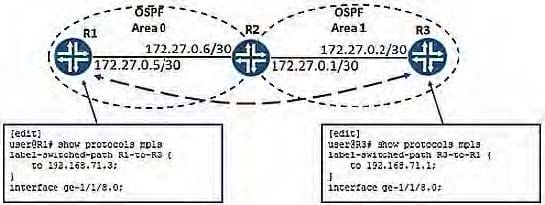
Referring to the exhibit, which statement is correct?
A. You must disable CSPF for the LSPs.
B. You must enable CSPF for the LSPs.
C. You must ensure type 5 LSAs are allowed in area 1.
D. You must ensure OSPF traffic engineering is configured.
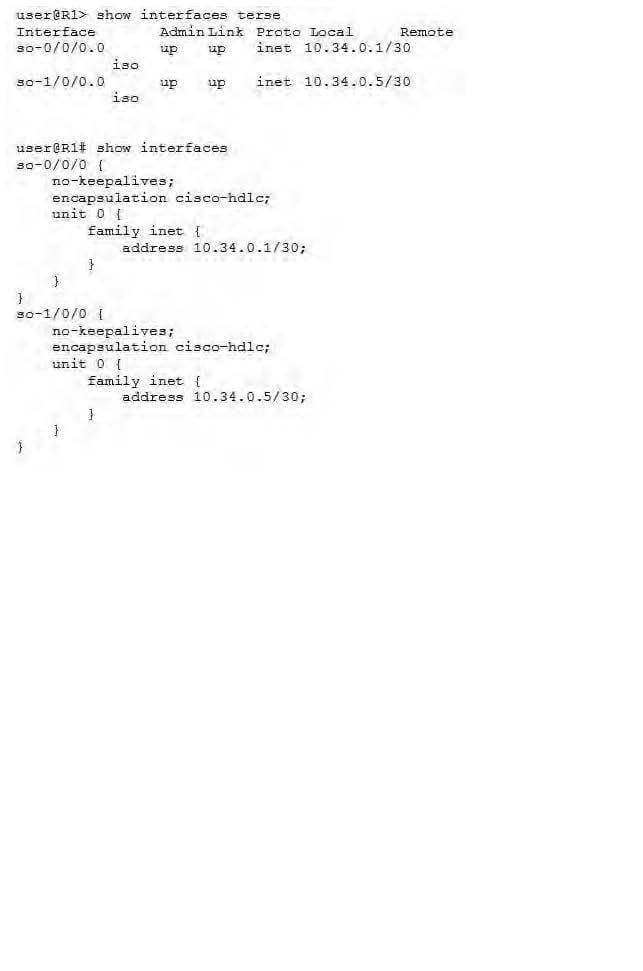
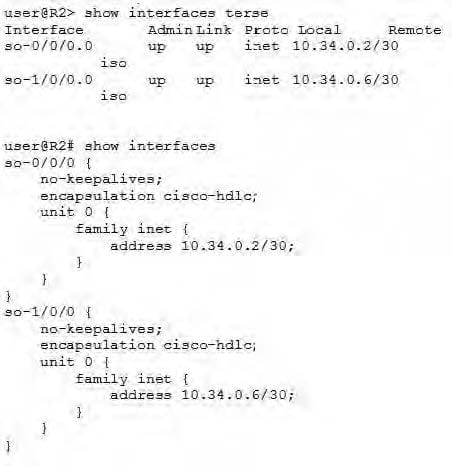
You have created a new IS-IS adjacency between identical routers over two STM-4 circuits. After enabling no-keepalives on the interfaces, they come up and you are able to ping between the routers. However, the IS-IS adjacency still will not establish.
Which step will determine the cause of the problem?
A. Disable no-keepalives from the interfaces and issue a show isis adjacency command.
B. Enable family iso on all the SONET interfaces, commit, and test the circuits.
C. Disable cisco-hdlc encapsulation, enable ppp encapsulation, commit, and test the circuits.
D. Disable no-keepalives from the interfaces and issue a show interfaces extensive command for each of the SONET interfaces.

You have configured an IS-IS adjacency between routers R1 and R2. However, the adjacency is not coming up. Referring to the exhibit, what appears to be the problem?
A. The R2 interface is down.
B. The ge-1/1/2.0 interface has IS-IS level 2 disabled.
C. The ge-1/1/2.0 interface does not have family iso configured.
D. The ge-1/1/2.0 interface has IS-IS level 1 disabled.
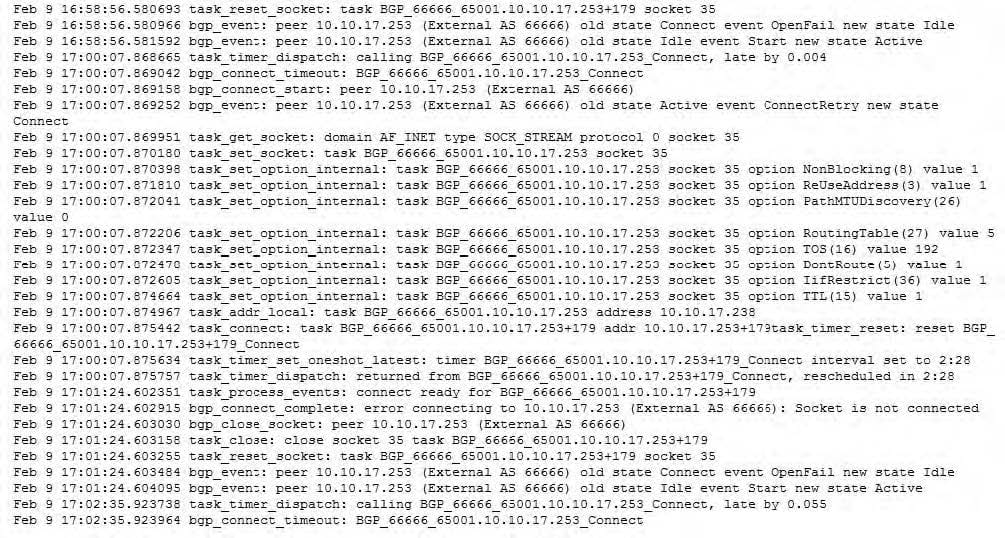
You are asked to configure an EBGP peering, but the peering does not establish and transitions between the Connect and Active states.
Referring to the exhibit, what is causing the problem?
A. The number of messages from the BGP peer has exceeded the receive socket buffer.
B. An incorrect local AS has been configured in the BGP group configuration.
C. BGP is waiting to receive a keepalive or notification message from the peer.
D. The BGP peer has an incorrect address configured, causing a connectivity failure.
You recently added your autonomous system to an existing BGP confederation. You notice that a route that had a local preference of 100 now has a local preference of 50. Which statement explains the change?
A. BGP path attributes such as next hop, local preference, and MED are normally restricted to a single AS but are allowed to propagate throughout the confederation's AS members.
B. The confederation has sub-ASs that require all IBGP routes to have a local preference of 50 or below.
C. When your Junos devices joined the confederation, they lost IBGP connectivity to the route in question; the local preference reverted to 50 once the BGP peering established.
D. The route is being shared through an EBGP peer, and the confederation is propagating the local preference from the peer.
Click the Exhibit button.
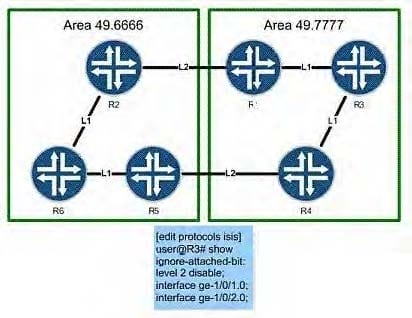
Based on the exhibit, what do you expect to find in the configuration on R1 and R4?
A. a policy leaking level 1 routes into level 2
B. a policy leaking level 2 routes into level 1 C. a policy setting the attached bit on level 2 routes
D. a policy setting the attached bit on level 1 routes
Click the Exhibit button.

Customer A is complaining that CE1 and CE2 cannot form an OSPF adjacency across your LDP Layer 2 circuit. The physical topology of the network is CE1-PE1-P-PE2-CE2. PE1's loopback is 192.168.5.1, P's loopback is 192.168.6.1, and PE2's loopback is 192.168.7.1.
Referring to the output in the exhibit, what is the problem?
A. mismatched virtual circuit ID values
B. mismatched interface encapsulations
C. incorrect PE-CE interface configuration
D. extended LDP neighbor not established
Click the Exhibit button.

The exhibit shows the output of a Junos show bgp neighbor command. Which two statements are true? (Choose two.)
A. IPv4 routes will be exchanged over this session.
B. IPv6 routes will be exchanged over this session.
C. The local router initiated the BGP session.
D. BFD keepalive is configured to 30 seconds.
In an interdomain multicast deployment scenario, an RP1 is in AS1 and an RP2 is in AS2. MSDP is configured between RP1 and RP2.In which routing table on RP1 are source- active messages (SAs) received from RP2 by default?
A. inet.0
B. inet.2
C. inet.1
D. inet.4
Click the Exhibit button.

R3 and R4 want to establish an EBGP session between each other's loopback addresses. They have each configured static routes to the other's loopback address and can ping from loopback to loopback. Their EBGP session is configured with correct neighbor and local addresses. The correct AS numbers have been specified at the [routing-options] hierarchy as well. Considering the topology in the exhibit, which statement is true?
A. BGP's protocol preference must be adjusted to be lower than protocol static for the session to establish.
B. Each side must configure multipath for the session to establish.
C. Each peer must specify a local-as within their EBGP configuration for the session to establish.
D. Each peer must configure multihop for the session to establish.
Click the Exhibit button.

Referring to the exhibit, which statement is correct?
A. Only multicasts packets (224.0.1.39) are allowed on the input and output direction.
B. Auto-RP discovery messages are filtered in the input and output direction.
C. Rendezvous point announcements are filtered in the output direction.
D. This filter does not work because the input or output parameter is missing.
Click the Exhibit button.
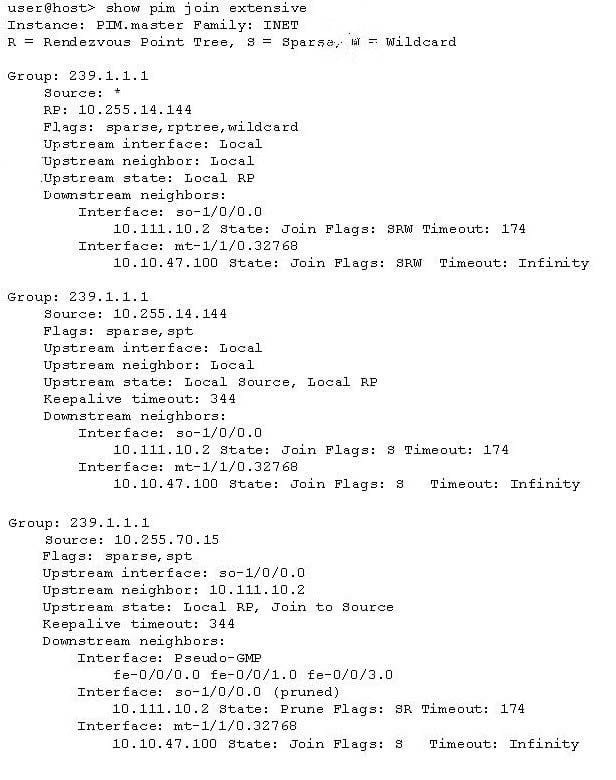
Given the output in the exhibit, which three statements are correct? (Choose three.)
A. PIM spare-dense mode is used.
B. PIM sparse mode is used.
C. The receiver and source 10.255.70.15 are on the shortest path tree.
D. The receiver and source 10.255.70.15 are on the shared tree.
E. The receiver and RP are on the shortest path tree.
Click the Exhibit button.
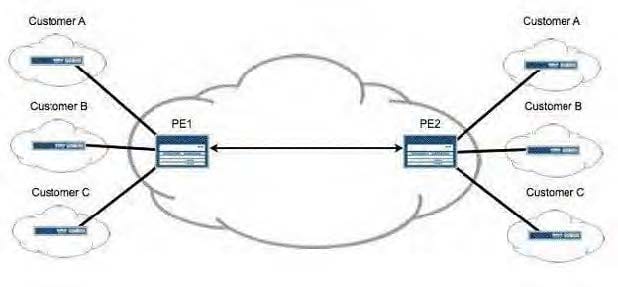
After adding Customer C to your Layer 3 VPN, you must validate that PE2 is receiving VPN routes for all customers attached to PE1, as shown in the exhibit. Which operational command displays this information?
A. show route instance
B. show route summary
C. show route table bgp.l3vpn.0
D. show route table customer-c.inet.0
You are configuring CoS schedulers on an M Series router. For some queues, you want to limit throughput to the configured transmit rate, and buffer excess traffic.
Which two transmission rate options can you use? (Choose two.)
A. exact
B. rate-limit
C. remainder
D. shaping-rate
Click the Exhibit button.
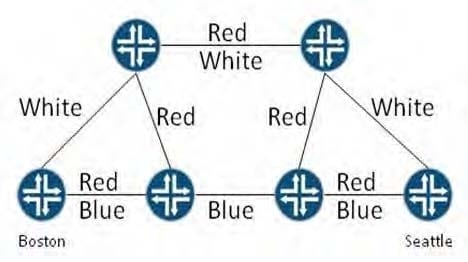
On the network shown in the exhibit, a network administrator is attempting to bring up an LSP between Boston and Seattle using administrative groups.
Which two of the following LSP configurations allow the LSP to establish? (Choose two.)
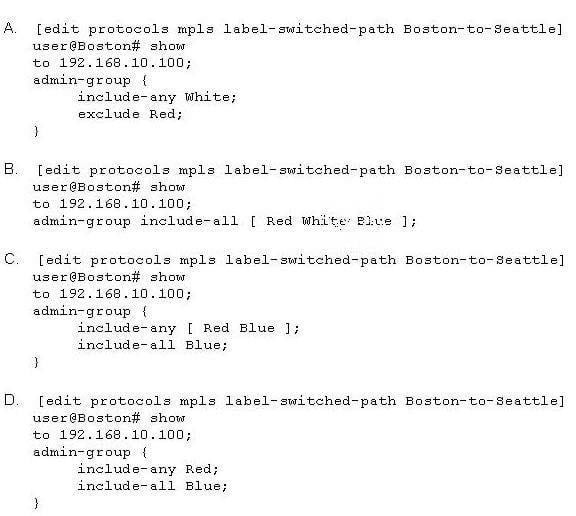
A. Option A
B. Option B
C. Option C
D. Option D
